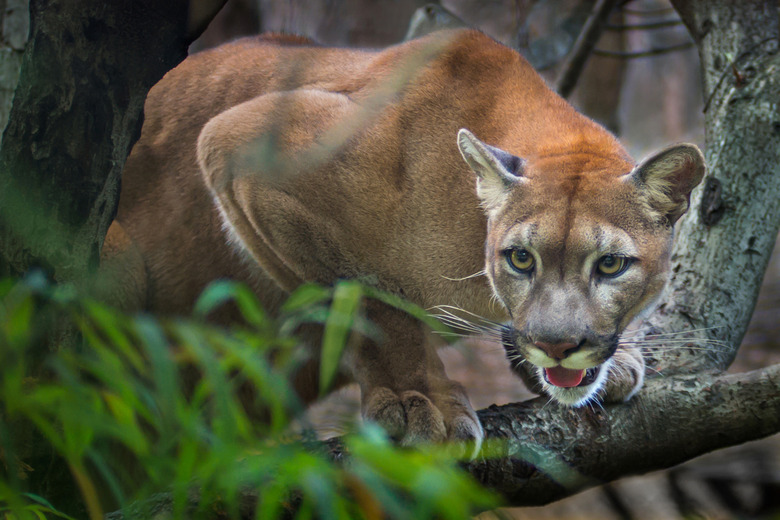The Differences Between A Puma, A Cougar And A Mountain Lion
Few large mammals enjoy so many common names as the puma (Puma concolor), the second-largest cat in the Americas after the jaguar. This supple and muscular hunter has an enormous range — from the Yukon to Patagonia — which may partly explain all the nomenclatural variety. In popular usage, "cougar" and "mountain lion" are the most widespread alternate monikers for the cat, but many others exist.
"Puma," "Cougar" and "Mountain Lion"
"Puma," "Cougar" and "Mountain Lion"
In "The Cougar Almanac: A Complete Natural History of the Mountain Lion," Robert H. Busch lays out the derivation of the puma's two best-known names, both of which have their roots in South America. In the 19th century, a French naturalist conjoined two indigenous names for the jaguar — which widely overlaps geographically with the puma — to label the mountain lion "cuguar," later modified to "cougar." "Puma," meanwhile, means "powerful animal" in Peruvian Quechua. "Mountain lion," while widely used, is a somewhat more misleading label: True lions belong to a different genus (Panthera) and live only in the Old World, and pumas are by no means restricted to mountainous habitat.
Other Names
Other Names
Native Americans and Euro-Americans have bestowed numerous other epithets upon P. concolor. Busch mentions just a few of the many indigenous North American monikers, including the Cree "Katalgar" — "Greatest of Wild Hunters" — and the Chickasaw "Ko-Icto," which means "Cat of God." Christopher Columbus referred to the New World's "lions," and some settlers applied the name "tiger" or "tyger" to the puma, though this most commonly referred to the jaguar. Early American colonists commonly called the carnivore "catamount" or "carcajou," a French-Canadian/Algonquin term more widely used for the wolverine. "Panther," which means "leopard" in Greek, is another puma tag that's lived on from colonial days, sometimes in the colloquial variant "painter"; an imperiled population now restricted to the Florida peninsula is known as the Florida panther. Still other names include swamp screamer, Indian devil and ghost cat.
Introducing the Cat
Introducing the Cat
Although they're closely related to and share many physical traits with small cats, pumas are more similar to the big cats — species in the genus Panthera — in size and ecology. Large males may weigh up to 113 kilograms (250 pounds) or more. Long, muscular hindlegs give pumas superb jumping ability: They've been documented making horizontal leaps of 14 meters (45 feet), and one cat was seen springing 3.6 meters (12 feet) into a tree while hoisting a deer carcass. They're at home in a staggering variety of settings, from desert scrub to tropical rainforest to rugged subalpine forest. They favor as prey medium- to large-sized mammals such as deer, elk and guanacos, but across their range pumas have a very broad diet: They'll also eat raccoons, hares, birds, snakes and other small creatures.
The Latin Name
The Latin Name
"Concolor," the species name for the puma, is Latin for "of one color." This is an apt description of the animal, as pumas are uniformly plain in hue. Their coats are tawny, reddish or grayish brown — although occasionally melanistic, or all-black, individuals are recorded. Cubs, meanwhile, are patterned with spots and stripes that fade with age. On an adult puma, the most intricate coloration typically lies on the face, often defined by bold black accents around the muzzle as well as black marks on the backs of the ears.
References
Cite This Article
MLA
Shaw, Ethan. "The Differences Between A Puma, A Cougar And A Mountain Lion" sciencing.com, https://www.sciencing.com/differences-puma-cougar-mountain-lion-8514376/. 13 March 2018.
APA
Shaw, Ethan. (2018, March 13). The Differences Between A Puma, A Cougar And A Mountain Lion. sciencing.com. Retrieved from https://www.sciencing.com/differences-puma-cougar-mountain-lion-8514376/
Chicago
Shaw, Ethan. The Differences Between A Puma, A Cougar And A Mountain Lion last modified March 24, 2022. https://www.sciencing.com/differences-puma-cougar-mountain-lion-8514376/
